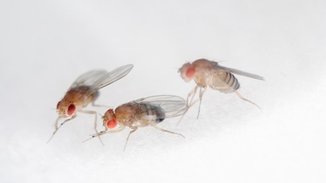Insect Brain System Knows What You Want
By Christopher Intagliata on November 10, 2017
虫子知道你想要什么
Computer scientists borrowed insights from the fruit fly brain to create a more accurate search algorithm. Christopher Intagliata reports.
计算机科学家借鉴了果蝇大脑的判别力,来开发更精准的检索算法。克里斯托弗•因塔利亚塔(Christopher Intagliata)报导。
撰文\播音:克里斯托弗•因塔利亚塔(Christopher Intagliata)
翻译:许楠
审校 张清越
The goal for a lot of tech companies today: figure out what you, their customer, want next, before you even ask. It's driven by something called similarity search.
现代很多技术公司的目标是在你——他们的客户——发问前,找到你的下一步的需求。这可由所谓的“相似搜索”驱动。
"If you go to YouTube and you watch a video they're going to suggest similar videos to the one you're watching. That's similarity search. If you go to Amazon and look for similar products to the one you're going to buy, that's similarity search."
“如果你登录YouTube观看一个视频,他们就会寻找与之相近的视频推送给你。这就叫‘相似搜索’。如果你登录亚马逊,浏览与你想要买的东西相似的商品,这也是‘相似搜索’。”
Saket Navlakha, a computer scientist at the Salk Institute. He says we do similarity searches, too, for example, when we scan faces in a crowd for the one we know. And even fruit files do a version, related to smell:
沙克学院(Salk Institute)的一名计算机科学家,萨克特•纳夫莱卡(Saket Navlakha)说,我们日常生活里也会进行相似搜索,比如,在扫视人群的时候,我们会从中找到自己认识的人。甚至果蝇也可以执行嗅觉版的相似搜索。
"So the fly is having to solve a similar problem, of kind of searching through its database of previous experiences and previous odors it has smelled, to determine what should be the most appropriate behavioral response to that odor."
“果蝇需要处理类似的问题:从它之前的经验和闻过气味的数据库里进行搜索,来决定对特定气味的最佳反应。”
But flies tag incoming odors differently from the way modern search algorithms parse similarity. A small group of neurons makes an initial evaluation of the smell. Then a much larger set of neurons is activated to make a final decision about the smell. Rather than the way a computer similarity search does it, taking something with many dimensions, and simplifying it down to a few.
但是果蝇对外来气味的识别方式与现代相似算法的分析有所不同。有一小组神经元会对该气味进行初步评估,然后另外一组数量更庞大的神经元被激活来对气味进行最终判断。与之不同,电脑的相似搜索则会从多个维度考量搜索对象,然后再将之简化至少数几个。
So Navlakha and his colleagues tweaked computer similarity search functions to do it fly style. And then pitted the fly-inspired algorithms against conventional ones. And the biologically inspired code won out, better at telling "like" from "unlike" on an image-similarity test.
纳夫莱卡和他的同事们也令计算机执行果蝇式的分析步骤。与传统算法进行相比,在区分图像相似性测试中,仿生代码胜出。
"You know evolution figured it out, it figured out a very elegant solution to this very important problem." The report is in the journal Science. [Sanjoy Dasgupta et al., A neural algorithm for a fundamental computing problem]
“这是进化筛选的结果,它找到了非常优雅的方案来解决这种重要问题。”这一结论被发表在《科学》(Science)上。[Sanjoy Dasgupta et al., A neural algorithm for a fundamental computing problem]
Navlakha says he and his team are looking to partner with tech companies now, in hopes of endowing machines with the time-tested problem-solving abilities of the brain. Even if it’s a fruit fly brain.
纳夫莱卡说,现在他和他的团队期待可以与技术公司合作,希望他们有机会赋予计算机这种历经自然选择的大脑处理问题的能力。即使这只是果蝇的大脑。
—Christopher Intagliata
——克里斯托弗•因塔利亚塔

 京公网安备11010502039775号
京公网安备11010502039775号  京公网安备11010502039775号
京公网安备11010502039775号 
















